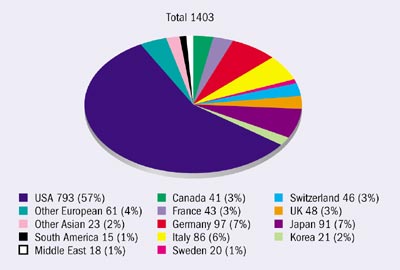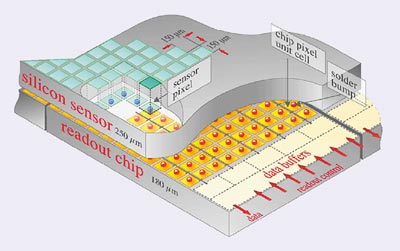The IEEE Nuclear Science Symposium and Medical Imaging Conference provides a unique – and increasingly popular – annual event for scientists and engineers to come together to review progress in detection and instrumentation techniques.
About 35 years ago the physics community of the Institute of Electrical and Electronics Engineers (IEEE), currently the world’s largest professional science and engineering organization with more than 360,000 members worldwide, established the Nuclear Science Symposium (NSS) as one of its major annual events. The NSS had originally evolved from IEEE meetings on scintillation (and then semiconductor) detectors before being formally established in 1969. In the following years interest in the NSS grew substantially with additional subjects being added, including a session on medical imaging, which soon developed into a major parallel conference at the week-long meeting.

The Nuclear Science Symposium and Medical Imaging Conference (NSS/MIC) has since grown into a well known, highly respected, and important event for scientists worldwide working in the fields of particle and nuclear physics instrumentation, radiation detection, the associated hardware, electronics and software, and on applications in fields such as medicine. With the numbers of conference contributions (shared roughly equally between NSS and MIC) almost doubling in recent years, and a record number of more than 1600 scientific contributions received for this year’s meeting in Rome, the combined NSS/MIC, together with its specialized workshops, educational courses and industrial programme, has developed into a truly global forum for scientists and engineers active in these fields (see figure 1).
Early history and mission
The NSS was formally established as a broad nuclear instrumentation conference under the sponsorship of the IEEE Professional Group on Nuclear Science (PGNS). The visionary behind the formation of both the IEEE Nuclear Sciences Society and the NSS was Louis Costrell of the National Bureau of Standards in Washington DC, who later pioneered many nuclear instrumentation standards (such as NIM, CAMAC, FASTBUS and VMEp), with the collaboration of the European Standards on Nuclear Electronics organization and many international collaborators. The PGNS became a full society of the IEEE in 1970, elected its first administrative committee (AdCom) in 1971, and soon combined with the Professional Group on Plasma Sciences to become the Nuclear and Plasma Sciences Society (NPSS). In response to high interest among medical physicists, the Medical Imaging Technical Committee was formed in 1975, chaired by Leon Kaufman of the University of California at San Francisco Medical Center. Others prominent in its formation were Bertrand A Brill of Emory University and Glenn Knoll of the University of Michigan. As an elected member of this first NPSS AdCom, Ray Larsen of SLAC assisted in its organization. By 1990 the medical imaging sessions had grown to the point where the NSS became the joint Nuclear Science Symposium and Medical Imaging Conference (NSS/MIC).
The early NSS/MIC meetings included special sessions on various aspects of nuclear instrumentation, nuclear-reactor controls, detector instrumentation and instrumentation for medical imaging sciences. This was the heyday of the development of new imaging CAT scanners in industry, exciting new modular electronics for accelerator instrumentation and detectors, as well as applications in many areas of nuclear-physics research. With the advent of proportional wire chambers and later custom-built silicon detectors, increasingly sophisticated generations of integrated electronics readout systems for applications in both physics and medicine were developed.
The main mission of the NSS/MIC is to serve the scientific community by providing an annual forum and meeting point to present and discuss work, problems and the latest advances in the relevant fields, to the benefit of all participants. The rapid publication of conference proceedings, including on CD, is invaluable, as is access to the authors at the conference. Papers can also be submitted for publication in peer-reviewed archival journals; this takes much longer but is more prestigious to academics. All publications are distributed worldwide.
Recently, the organizers of NSS/MIC have emphasized their desire for feedback from the scientific community for shaping future meetings. Young scientists doing outstanding work in the various fields covered by the NSS/MIC are particularly encouraged to contribute to the conference. In addition, NSS and MIC technical achievement, fellow, best paper and graduate student awards are presented at the conference both to younger and more mature scientists and engineers nominated by their peers or advisors. (Nominees do not have to be a member of the IEEE or the NPSS).
Typical NSS/MIC programmes consist of plenary, parallel and poster sessions, workshops on specialized topics, educational short courses and an industrial programme with an exhibition and seminars. Special events and an extensive social and companion programme round out the week. This seems to provide an ideal environment for very fruitful, beneficial, and increasingly more important interdisciplinary communication between the various fields, the contributing experts and communities, and their industrial partners. To facilitate and emphasize this important aspect of the meeting, the organizers include as much time and as many opportunities as possible for participants, including those from different fields, to get together. Moreover, seeking constant improvement year-to-year, the organizers are careful to request feedback from all participants.

The joint conference has produced a unique synergy among many disciplines, reaping benefits for a wide range of engineers and scientists. In addition to regular sessions in the various areas of interest, the conference has pioneered the use of posters, continuing education short courses, and special plenary sessions that feature world-class presenters of the latest research on accelerators, nuclear medical imaging, detectors and instrumentation for high-energy physics, space physics, environmental detection, reactor controls and nuclear security systems.
Pushing boundaries in Portland
The 2003 meeting in Portland, Oregon, attracted the largest number of participants to date (see figure 2). Chaired by Uwe Bratzler of CERN and NTU Athens (now at Tokyo Metropolitan University) and Maxim Titov of Freiburg University and ITEP Moscow for the NSS, and Mike King and Stephen Glick of the University of Massachusetts for the MIC, with Ralph James of Brookhaven National Laboratory as the overall conference general chair, it provided a comprehensive review of the progress and latest developments in technology and instrumentation and their implementation in experiments for space, accelerators and other radiation environments. The scientific programme underlined the interdisciplinary and synergetic combinations of the NSS and MIC topics, and covered a wide range of applications from radiation instrumentation and new detector materials, to complex radiation detector systems for physical sciences and advanced imaging systems for biological and medical research. Special emphasis was also put on the transfer of technology between fundamental physics research, medical and biological imaging science and industrial applications. More than 572 accepted submissions for the NSS were accommodated in 323 oral presentations and 249 poster contributions.
The field of high-energy particle physics featured widely in Portland, with presentations of innovative research on semiconductor devices by groups working on experiments being prepared for high-luminosity hadron colliders, in particular the Large Hadron Collider (LHC) at CERN, including many impressive front-end electronics systems that are either in or close to being in production. A large number of talks on pixel systems, with comprehensive contributions on deep sub-micron front-ends, radiation-hard detectors, bump bonding and new integrated approaches, gave good insight into the interplay between the progress in technology and requirements for tracking close to the interaction point in the high-intensity collider experiments. Many developments, motivated by the prospects of a linear collider where higher resolution, less material and power are mandatory, are pushing the boundaries of semiconductor detector technology.

Progress in micro-pattern gas detectors was represented by more than 30 contributions. The evolution of gaseous detectors to novel 2D and pixel readout electrodes, together with their intrinsic excellent radiation tolerance, rate capability and spatial resolution, extends their applicability to precision tracking at high counting rates in hostile environments, an area that is currently accessible only to silicon detectors. The many sessions on large systems and more specific topics under development underlined that finding the optimum balance between power, cooling capacity, granularity and performance is the key for further progress in the field of detectors.
In Portland, an International Workshop on Room-Temperature Semiconductor X-Ray and Gamma-Ray Detectors, chaired by Ralph James of Brookhaven and Paul Siffert of Laboratoire Phase, Strasbourg, was held in conjunction with the NSS/MIC meeting, and five topical “satellite” workshops covered areas of specific interest. Workshops on the Compton camera and hadron therapy were combined with full-day workshops on topics of major importance for high-energy physicists involved in the current construction or future upgrades of experiments. The workshop “Problems with Detector Fabrication, Testing, Quality Control and Long Term Operation” provided a thorough review of the problems encountered during production, quality control, and medium- and long-term operation of large systems. The “Detector Aging Workshop”, a follow-up of the workshop that was held at DESY in 2001, once again gathered many experts on this critical matter. Fruitful discussions took place between the groups running the experiments and others currently building detectors for the BTeV experiment at Fermilab and the experiments at the LHC. Trends were discussed and almost agreed upon! The major concerns for all of the groups seem to be the selection of gas mixture, chamber materials and the associated gas system components, and the problems related to CF4-induced etching on materials. Radiation hardness studies should also be performed for the muon detectors in high-luminosity experiments – systems that are so far comfortably coping with low instantaneous rates and negligible radiation doses.

Rome and beyond
The IEEE NSS/MIC conference is the instrumentation “Mecca” and is unique in the world; no other conference has such a broad synergistic combination of topics. While its roots are clearly in the US, the IEEE has repeatedly stated its objective to be a truly transnational organization, and its largest growth is currently outside the US. The 2004 NSS/MIC conference is taking place in Rome on 16-22 October at the Ergife Palace Hotel, one of the largest exhibition and congress areas in Europe. The 2004 IEEE NSS/MIC committee includes Alberto Del Guerra of Pisa as general chair; Fabio Sauli and Archana Sharma of CERN as programme chair and deputy chair for NSS, respectively; Sibylle Ziegler of the Technical University, Munich, and Michel Defrise of the Free University, Brussels, as programme chair and deputy chair for MIC, respectively. As it has become an IEEE-wide decision to encourage more conferences outside the US, the NSS/MIC will be held abroad every three to four years. After Lyon in 2000 and Rome in 2004, the next overseas conference is being considered for 2008.
One of the main goals of the IEEE, according to its constitution, is as follows: “The IEEE shall strive to enhance the quality of life for all people throughout the world through the constructive application of technology in its fields of competence. It shall endeavor to promote understanding of the influence of such technology on the public welfare.” As our scientific fields, including industry, benefit more and more by transnational interdisciplinary exchange, the IEEE NSS/MIC will continue to help fulfill this mandate by providing a unique forum for communication and open sharing of experience among a broad range of scientists and engineers worldwide.
Further reading
For an extensive overview of the 2003 meeting at Portland, see the talk given at CERN by Mar Capeans, www.cern.ch/PL2003. For further information on the NSS/MIC meeting in general, see www.nss-mic.org, or contact Uwe.Bratzler@cern.ch.





